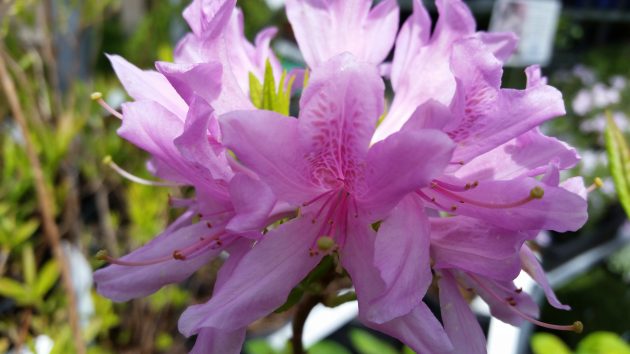Azaleas for the North
Azaleas can make a beautiful addition to any landscape. They are an early flowering shrub that adds spectacular spring colour to the yard. Many of them are now in bloom, or will soon be blooming over the next few weeks depending on location.
They are not the easiest plant to grow, but when done right, they are certainly well worth the effort. There are many different varieties of azaleas but very few of them are hardy enough to withstand our zone 3 winters.
A few years ago the University of Minnesota developed a series of cold hardy azaleas by crossing hardy native azaleas with large-flowered garden types, and this is how the ‘Northern Lights Series’ of azaleas became available. Northern Lights are available in a wide variety of shades and the flowers have the added bonus of being fragrant. In mid/late-spring the plant is stunning as it is draped in clusters of tubular flowers found at the tips of the branches, soon followed by the green foliage.
The hardiest of this series is ‘Orchid Lights’ which has pink-lilac flowers. The dwarf, compact shrub has narrow leaves that turn bright yellow in fall. 
Azaleas can be fussy, so choose the planting site carefully to avoid disappointment. In nature they grow in wooded areas, in a well-drained acidic soil, with lots of organic matter.
They can not sit in water for any period of time as this will cause the roots to rot, and they are not drought tolerant. If the soil is not well-drained, plant them on a mound or on a slope so that they are not sitting in water. Backfill the planting hole with a mixture of peat moss and compost and this will help with the acidic soil. They will grow in full sun to partial shade. Ideally they should be planted in an area where there is some shelter from the wind. Azaleas have a shallow root system and will benefit from having a 5-8 cm layer of mulch placed around the plant as this will help keep the soil moist and cool, and weeds down. Composted spruce or pine needles make a great mulch and will also help in increasing the soil acidity. After they have been planted, water the plant regularly as they like a moist but not wet soil.
Once established, azaleas do not require a lot of maintenance. They do not need to be pruned. After they have finished blooming, remove the finished flowers just above a set of leaves. Azaleas form their flower buds in late summer/early fall, of the previous year so only prune them right after they have finished blooming or else you will be removing next year’s flower crop.
Fertilize the plants in the spring and then again in early summer with an azalea/rhododendron acidic fertilizer. They are rarely bothered by pests and can sometimes be prone to powdery mildew which can be prevented by giving them good air-circulation and preventing the foliage from getting wet.
Azaleas are a beautiful, multi-stemmed, deciduous flowering shrub, that will reward you with years of seasonal colour if planted correctly in the right location.
-Jos
Jos Van Hage owns and operates two Art Knapp Home and Garden Centres in Prince George:
- Highway 16 West at Kimball Road
- Highway 97 North at Northwood Pulpmill Road


Comments
Comments for this article are closed.